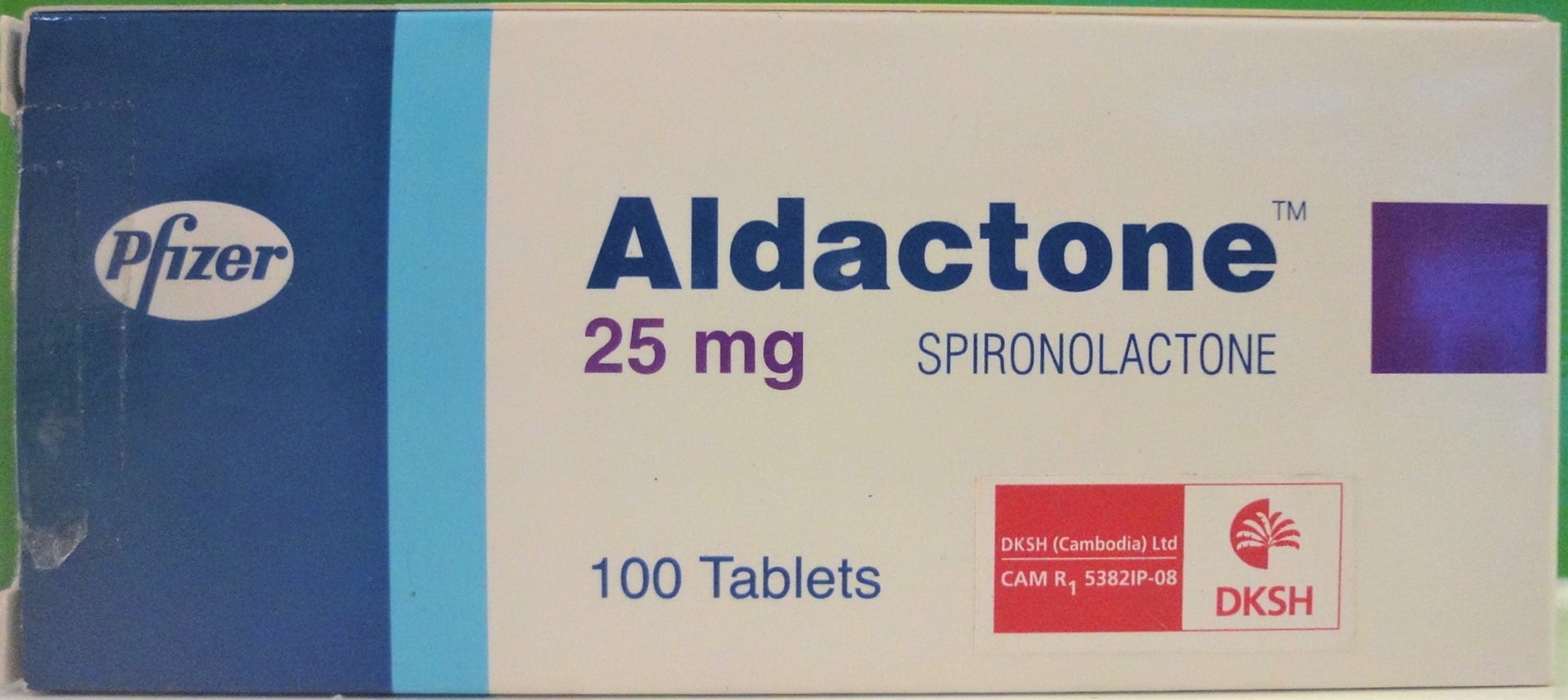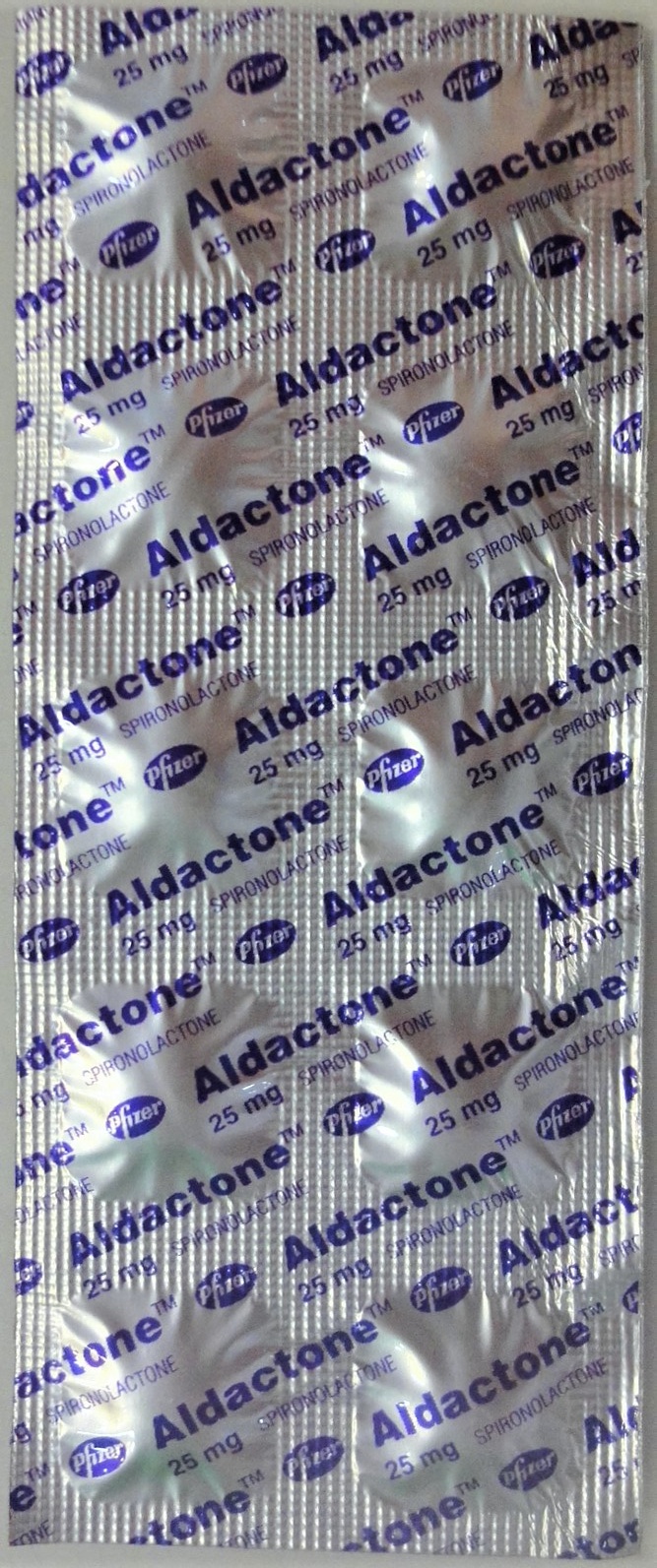ALDACTONE Tablet
ក្រុមហ៊ុនផលិតឱសថ:
OLIC (Thailand) Limited, Thailand
ក្រុមហ៊ុនចែកចាយឱសថនៅប្រទេសកម្ពុជា:
DKSH


- សារធាតុសកម្ម
- ប្រសិទ្ធិភាពព្យាបាល និង កម្រិតប្រើប្រាស់
- ហាមប្រើ
- ផលរំខាន
- អន្តរប្រតិកម្ម
- ស្ត្រីមានផ្ទៃពោះ និង ស្ត្រីបំបៅដោះកូន
- ការប្រុងប្រយ័ត្នជាពិសេស
- សកម្មភាពឱសថ បរិយាយប័ណ្ណឱសថ
-
សារធាតុសកម្ម
Spironolactone 25mg
-
ប្រសិទ្ធិភាពព្យាបាល និង កម្រិតប្រើប្រាស់
គុណភាពព្យាបាល៖
Spironolactone ជាឱសថប្រើសម្រាប់ព្យាបាលដូចតទៅនេះ៖
- សម្ពាធឈាមឡើងខ្ពស់
- មុនពេលវះកាត់រយៈពេលខ្លីចំពោះអ្នកជំងឺដែលមានការចេញ aldosterone ច្រើនជ្រុលដោយសារមានដុំពកនៅក្រពេញ adrenal cortical
- ជំងឺបេះដូងដែលមិនអាចច្របាច់ឈាមដល់ចុងដៃជើង
- ជំងឺដែលមានការចេញ aldosterone ច្រើនជ្រុលដោយសារមានការរំញោចក្រពេញ adrenal cortical រួមមានក្រិនថ្លើមដោយមានដុំពក និង/ឬទាចទឹក រោគសញ្ញា nephron និងជំងឺហើមផ្សេងទៀត
- ជាតិប៉ូតាស្យូម/ម៉ាញេស្យូមតិចក្នុងឈាមដោយសារឱសថបញ្ចុះទឹកនោមដែលជាការព្យាបាលជំនួយ
- ធ្វើរោគវិនិច្ឆ័យនៃជំងឺដែលមានការចេញ aldosterone ច្រើនជ្រុលដោយសារមានដុំពកនៅក្រពេញ adrenal cortical
- គ្រប់គ្រងការដុះរោមច្រើន
កម្រិត និងរបៀបប្រើ៖
ចំពោះមនុស្សពេញវ័យ កម្រិតប្រើប្រចាំថ្ងៃអាចចែកជាច្រើនដង ឬប្រើតែមួយដងគត់។
- សម្ពាធឈាមឡើងខ្ពស់៖ មនុស្សពេញវ័យ៖ ៥០-១០០ម.ក្រ/ថ្ងៃ។ ក្នុងករណីធ្ងន់ធ្ងរកម្រិតប្រើត្រូវបង្កើនបន្តិចម្តងៗចន្លោះពេល ២អាទិត្យរហូតដល់ ២០០ម.ក្រ/ថ្ងៃ។ ការព្យាបាលត្រូវបន្តយ៉ាងហោចណាស់ ២អាទិត្យដើម្បីធានាឱ្យមានការឆ្លើយតបការព្យាបាល។
- ជំងឺបេះដូងដែលមិនអាចច្របាច់ឈាមដល់ចុងដៃជើង៖ កម្រិតប្រើដំបូង ១០០ម.ក្រ លេបតែមួយដងគត់ក្នុង ១ថ្ងៃ ឬចែកជាច្រើនដង កម្រិតប្រើចាប់ពី ២៥-២០០ម.ក្រ។
- បេះដូងខ្សោយខ្លាំងដោយមានការព្យាបាលស្តង់ដារ (NYHA Class III I-IV)៖ លេប ២៥ម.ក្រ ១ដង ក្នុង១ថ្ងៃ ចំពោះអ្នកជំងឺមានប៉ូតាស្យូមក្នុងសេរ៉ូម ≤៥,០ mEq និង Creatinine ≤២,៥ mg/dl។ អ្នកជំងឺដែលមានភាពអនុគ្រោះប្រើបាន ២៥ម.ក្រ ១ដងក្នុង១ថ្ងៃ អាចបង្កើនកម្រិតប្រើដល់ ៥០ម.ក្រ ១ដងក្នុង១ថ្ងៃ ទៅតាមគ្លីនិក។ អ្នកជំងឺដែលមិនមានភាពអនុគ្រោះប្រើ ២៥ម.ក្រ ១ដងក្នុង១ថ្ងៃអាចបន្ថយកម្រិតប្រើ ២៥ម.ក្រលេប១ថ្ងៃខាន១ថ្ងៃ។
- ក្រិនថ្លើម៖ បើសិនសមាមាត្រក្នុងទឹកនោមរបស់ Na+/K+ ធំជាង ១.០ កម្រិតប្រើមនុស្សពេញវ័យគឺ ១០០ម.ក្រ/ថ្ងៃ។ បើសិនសមាមាត្រក្នុងទឹកនោមរបស់ Na+/K+ តិចជាង ១.០ កម្រិតប្រើមនុស្សពេញវ័យគឺ ២០០-៤០០ម.ក្រ/ថ្ងៃ។
- រោគសញ្ញា Nephron ៖ លេប ១០០-២០០ម.ក្រ/ថ្ងៃ។
- ការហើមលើកុមារ៖ កម្រិតប្រើដំបូង ៣ម.ក្រ/គ.ក្រ/ថ្ងៃ ដោយចែកជាច្រើនដង។
- ជាតិប៉ូតាស្យូម/ម៉ាញ៉េស្យូមតិចក្នុងឈាម៖ លេប ២៥-១០០ម.ក្រ/ថ្ងៃ។
- ការធ្វើរោគវិនិច្ឆ័យ និងជំងឺដែលមានការចេញ aldosterone ច្រើនជ្រុលដោយសារមានដុំពកនៅក្រពេញ adrenal cortical៖
+តេស្តរយៈពេលយូរ៖ កម្រិតប្រើប្រចាំថ្ងៃមនុស្សពេញវ័យលេប ៤០០ម.ក្ររយៈពេល ៣-៤សប្តាហ៍។
+តេស្តរយៈពេលខ្លី៖ កម្រិតប្រើប្រចាំថ្ងៃមនុស្សពេញវ័យលេប ៤០០ម.ក្ររយៈពេល ៤ថ្ងៃ។
- មុនពេលវះកាត់រយៈពេលខ្លីចំពោះអ្នកជំងឺដែលមានការចេញ aldosterone ច្រើនជ្រុលដោយសារមានដុំពកនៅក្រពេញ adrenal cortical៖ កម្រិតប្រើប្រចាំថ្ងៃលេប ១០០-៤០០ម.ក្រនៅពេលត្រៀមវះកាត់។
- គ្រប់គ្រងការដុះរោមច្រើន៖ កម្រិតប្រើធម្មតាលេប ១០០-៤០០ម.ក្រ/ថ្ងៃដោយចែកជាច្រើនដង។
Spironolactone is indicated for the following:
- essential hypertension
- short-term pre-operative treatment of patients with primary hyperaldosteronism
- congestive heart failure (alone or in combination with standard therapy), including severe heart failure (New York Heart Association [NYHA] Class Ⅲ-Ⅳ) to increase survival and reduce the risk of hospitalization when used in addition to standard therapy
- conditions i which secondary hyperaldosteronism may be present, including liver cirrhosis accompanied by edema and/or ascites, nephrotic syndrome, and other edematous conditions (alone or in combination with standard therapy)
- diuretic-induced hypokalemia/hypomagnesemia as adjunctive therapy
- establishing a diagnosis of primary hyperaldosteronism
- management of hirsutism
Posology and method of administration
For adults, the daily dose may be given in divided doses or as a single daily dose.
Essential Hypertension
The usual adult dose is 50mg/day to 100mg/day, which for difficult or severe cases may be gradually increased at intervals of 2 weeks up to 200mg/day. Treatment should be continued for at least 2 weeks to ensure an adequate response to therapy. Dose should be adjusted as necessary.
Congestive Heart Failure
An initial daily dose of 100mg of spironolactone administered in either single or divided doses is recommended, but may range from 25mg to 200mg daily. Maintenance dose should be individually determined.
Sever Heart Failure in Conjunction with Standard Therapy (NYHA Class Ⅲ-Ⅳ)
Based on the Randomized Aldactone Evaluation Study (RALES), treatment in conjunction with standard therapy should be initiated at a dose of spironolactone 25mg once daily in patients with a serum potassium≤5.0mEq/L and serum creatinine ≤2.5mg/dL. Patients who tolerate 25mg once daily may have their dose increased to 50mg once daily as clinically indicated. Patients who do not tolerate 25mg once daily may have their dosage reduced to 25mg every other day.
Cirrhosis
If urinary Na+/K+ratio is greater than 1.0, the usual adult dose is 100mg/day. If the ratio is less than 1.0, the usual adult dose is 200mg/day to 400mg/day. Maintenance dose should be individually determined.
Nephrotic Syndrome
The usual adult dose is 100mg/day to 200mg/day. Spironolactone has not been shown to affect the basic pathological process, and its use is advised only if other therapy is ineffective.
Edema in Children
Initial dosage is 3mg/kg body weight daily in divided doses. Dosage should be adjusted on the basis of response and tolerance. If necessary, a suspension may be prepared by pulverizing spironolactone tablets with a few drops of glycerine and adding cherry syrup. Such a suspension is stable for 1 month when refrigerated.
Hypokalemia/Hypomagnesemia
25mg-100mg daily may be useful in treating diuretic-induced hypokalemia and/or hypomagnesemia when oral potassium and/or magnesium supplements are considered inappropriate.
Diagnosis and Treatment of Primary Hyperaldosteronism
Spironolactone may be employed as an initial diagnostic measure to provide presumptive evidence of primary hyperaldosteronism while patients are on normal diets.
Long test: Daily adult dose of 400mg for 3-4 weeks. Correction of hypokalemia and hypertension provides presumptive evidence or the diagnosis of primary hyperaldosteronism.
Short test: Daily adult dose of 400mg for 4 days. If serum potassium increases during spironolactone administration, but drops when spironolactone is discontinued, a presumptive diagnosis of primary hyperaldosteronism should be considered.
Short-Term Pre-operative Treatment of Primary Hyperaldosteronism
After the diagnosis of hyperaldosteronism has been established by more definitive testing procedures, spironolactone may be administered in daily doses of 100mg to 400mg in preparation for surgery. For patients who are considered unsuitable candidates for surgery, spironolactone may be employed for long-term maintenance therapy at the lowest effective dosage determined for the individual patient.
Management of Hirsutism
The usual dose is 100mg/day to 200mg/day, preferably in divided dose.
-
ហាមប្រើ
ហាមប្រើ៖
- ចំពោះអ្នកងាយប្រតិកម្មជាមួយសារធាតុផ្សំណាមួយ Spironolactone
- បើសិនមានតម្រងនោមខ្សោយស្រួចស្រាវ ខូចតម្រងនោមខ្លាំង អត់នោម
- ជំងឺ Addison
- មានកម្រិតប៉ូតាស្យ៉ូមទាបក្នុងឈាម
- ប្រើដំណាលគ្នាជាមួយ Eplerenone
Spironolactone is contraindicated in patients with the following:
- acute renal insufficiency, significant renal compromise, anuria
- Addison’s disease
- hyperkalemia
- hypersensitivity to spironolactone
- concomitant use of eplerenone
-
ផលរំខាន
ផលរំខានខ្លះៗ
ផលរំខានដូចតទៅនេះត្រូវបានគេរាយការណ៍ដោយសារការព្យាបាលដោយប្រើ Spironolactone ៖
- ដុំសាច់ស្រាល ដុំមហារីក និងមិនច្បាស់លាស់ (រួមមានគីស និងដុំសាច់ច្រមុះ) ដុំពកសាច់នៅដោះ
- វិបត្តិប្រព័ន្ធឈាម និងទឹករងៃ៖ ចំនួនគ្រាប់ឈាមសថយចុះ (agranulocyte ថយចុះ) ប្លាកែតថយចុះ
- វិបត្តិការបំលែង និងជីវជាតិ៖ វិបត្តិអេឡិចត្រូលីត ប៉ូតាស្យូមកើនក្នុងឈាម។
- វិបត្តិផ្លូវចិត្ត៖ ចំណង់ផ្លូវភេទប្រែប្រួល ការភាន់ច្រឡំ
- ប្រព័ន្ធសរសៃប្រសាទ៖ ធេងធោង
- វិបត្តិក្រពះពោះវៀន៖ វិបត្តិក្រពះពោះវៀន ចង្អោរ។
- វិបត្តិថ្លើម៖ មុខងារថ្លើមខុសធម្មតា
- វិបត្តិស្បែក និងជាលិកាក្រោមស្បែក៖ រោគសញ្ញា Steven johnson ពុករលួយស្បែក កន្ទួលក្រហមស្បែកដែល កន្ទាលត្រអាក។
- វិបត្តិសាច់ដុំជាប់ឆ្អឹង និងជាលិកាសន្ធាន៖ រមួលក្រពើ
- វិបត្តិតម្រងនោម និងការនោម៖ ខ្សោយតម្រងនោមធ្ងន់ធ្ងរ
- វិបត្តិប្រព័ន្ធបន្តពូជ និងដោះ៖ ឈឺដោះ វិបត្តិរដូវ ដោះឡើងធំ
- វិបត្តិទូទៅ និងកន្លែងចាក់៖ ល្ហិតល្ហៃ។
The following adverse events have been reported in association with spironolactone therapy:
Neoplasms benign, malignant and unspecified (including cysts and polyps): benign breast neoplasm
Blood and lymphatic system disorders: leucopenia (including agranulocytosis), thrombocytopenia
Metabolism and nutrition disorders: electrolyte disturbances, hyperkalemia
Psychiatric disorders: changes in libido, confusion
Nervous system disorders: dizziness
Gastrointestinal disorders: gastrointestinal disturbances, nausea
Hepatobiliary disorders: hepatic function abnormal
Skin and subcutaneous tissue disorders: Stevens-Johnson syndrome (SJS), toxic epidermal necrolysis (TEN), drug rash with eosinophilia and systemic symptoms (DRESS), alopecia, hypertrichosis. pruritis, rash, urticaria
Musculoskeletal and connective disorders: leg cramps
Renal and urinary disorders: acute renal failure
Reproductive system and breast disorders: breast pain, menstrual disorders, gynecomastia (Gynecomastia is usually reversible when spironolactone is discontinued, although in rare instances some breast enlargement may persist).
General disorders and administration site conditions: malaise
-
អន្តរប្រតិកម្ម
- ការប្រើដំណាលគ្នាឱសថដែលគេដឹងថាបង្កឱ្យជាតិប៉ូតាស្យូមកើនក្នុងឈាមជាមួយ Spironolactone អាចបណ្តាលឱ្យជាតិប៉ូតាស្យូមកើនក្នុងឈាមខ្លាំង។
- Spironolactone អាចមានប្រសិទ្ធភាពបន្ថែមពេលប្រើដំណាលគ្នាជាមួយឱសថបញ្ចុះទឹកនោមផ្សេងទៀត និងឱសថបញ្ចុះសម្ពាធឈាម។ កម្រិតប្រើឱសថទាំងនោះត្រូវបន្ថយពេល Spironolactone ត្រូវបានគេប្រើដំណាលគ្នា។
- Spironolactone បន្ថយការឆ្លើយតបនៅសរសៃឈាមជាមួយនឹង Norepinephrine ។ ប្រុងប្រយ័ត្នក្នុងការគ្រប់គ្រងអ្នកជំងឺប្រើឱសថសណ្តំពេលកំពុងព្យាបាលដោយ Spironolactone ។
- Spironolactone បង្ហាញថាបង្កើន half-life របស់ digoxin ។
- ឱសថ NSAIDs ដូចជា aspirin, indomethacin, និង mefenamic acid អាចបន្ថយប្រសិទ្ធភាពការបញ្ចុះសូដ្យូមតាមទឹកនោមដោយសាររាំងខ្ទប់សំយោគ prostaglandin នៅតម្រងនោម និងបង្ហាញបន្ថយប្រសិទ្ធភាពរបស់ Spironolactone ។
- Spironolactone បង្កើនការបំលែងរបស់ antipyrin ។
- Spironolactone អាចរំខានដល់កំហាប់ក្នុងបា្លស្មារបស់ Digoxin ពេលធ្វើតេស្ត assays
- វិបត្តិអាស៊ីដកើនក្នុងឈាមត្រូវបានគេរាយការណ៍ចំពោះអ្នកជំងឺប្រើ Spironolactone ដំណាលគ្នាជាមួយ ammonium chloride or chlestyramine ។
- ការប្រើដំណាលគ្នា Spironolactone ជាមួយ Carbenoxolone អាចបណ្តាលឱ្យប្រសិទ្ធភាពឱសថមួយក្នុងចំណោមឱសថពីរនេះថយចុះ។
Concomitant use of drugs known to cause hyperkalemia with spironolactone may result in severe hyperkalemia.
Spironolactone may have an additive effect when given concomitantly with other diuretics and antihypertensive agents. The dose of such drugs may need to be reduced when spironolactone is added to the treatment regimen.
Spironolactone reduces vascular responsiveness to norepinephrine. Caution should be exercised in the management of patients subjected to anesthesia while they are being treated with spironolactone.
Spironolactone has been shown to increase the half-life of digoxin.
NSAIDs such as aspirin, indomethacin, and mefenamic acid may attenuate the natriuretic efficacy of diuretics due to inhibition of intrarenal synthesis of prostaglandins and have been shown to attenuate the diuretic effect spironolactone.
Spironolactone enhances the metabolism of antipyrine.
Spironolactone can interfere with assays for plasma digoxin concentrations.
Hyperkalemic metabolic acidosis has been reported in patients given spironolactone concurrently with ammonium chloride or cholestyramine.
Co-administration of spironolactone with carbenoxolone may result in decreased efficacy of either agent.
-
ស្ត្រីមានផ្ទៃពោះ និង ស្ត្រីបំបៅដោះកូន
ស្ត្រីមានផ្ទៃពោះ និងបំបៅដោះ៖
ស្រ្តីមានផ្ទៃពោះ៖ បើសិនផលចំណេញច្រើនលើសផលរំខានដល់គភ៌។
បំបៅដោះកូន៖ Canrenone ជាមេតាបូលីតសំខាន់ (សកម្ម) របស់ Spironolactone ជ្រាបចូលក្នុងទឹកដោះម្តាយ។ ដោយឱសថនេះជ្រាបចូលទឹកដោះម្តាយ និងដោយសារគេមិនដឹងប្រតិកម្មរំខានរបស់ឱសថលើទារកបៅដោះ ការសម្រេចចិត្តត្រូវឈប់បំបៅដោះ ឬឈប់ប្រើឱសថដោយគិតពិចារណាសារសំខាន់ឱសថចំពោះម្តាយ។
There are no studies in pregnant women. Spironolactone should be used during pregnancy only if the potential benefit justifies the potential risk to the fetus.
Canrenone, a major (and active) metabolite of spironolactone, appears in human breast milk. Because many drugs are excreted in human milk and because of the unknown potential for adverse effects on the breast-feeding infant, a decision should be made whether to discontinue breast-feeding or discontinue the drug, taking into account the importance of the drug to the mother.
-
ការប្រុងប្រយ័ត្នជាពិសេស
- ការប្រើ Spironolactone ដំណាលគ្នាជាមួយឱសថបញ្ចុះទឹកនោមដែលរក្សាប៉ូតាស្យូម ឱសថរាំងខ្ទប់ ACE, NSAIDs ឱសថប្រឆាំង angiotensin II, aldosterone blockers, heparin, heparinដែលម៉ូលេគុលតូច ឬឱសថផ្សេង ឬជំងឺផ្សេងដែលគេដឹងថាបង្កើនប៉ូតាស្យូមអាចបណ្តាលឱ្យមានប៉ូតាស្យូមក្នុងឈាមកើនក្នុងឈាម។
- ប៉ាន់ប្រមាណអេឡិចត្រូលីតក្នុងសេរ៉ូមដោយសារអាចមានប៉ូតាស្យូមកើនក្នុងឈាម សូដ្យូមតិចក្នុងឈាម និងអាចមាន Urea nitrogen ក្នុងឈាមកើនឡើង ជាពិសេសលើមនុស្សចាស់ និង/ឬអ្នកជំងឺខ្សោយតម្រោងនោមពីមុនមក ឬខ្សោយមុខងារថ្លើម។
- ងងុយដេក និងធេងធោងកើតមានលើអ្នកជំងឺខ្លះ។ ប្រុងប្រយ័ត្នចំពោះអ្នកបើកបរ ឬបញ្ជាម៉ាស៊ីន។
- បញ្ហាអាស៊ីដកើនក្នុងឈាមដោយសារការបំលែងជាតិក្លរកើនក្នុងឈាម ជាទូទៅទាក់ទងជាមួយនឹងការកើនប៉ូតាស្យូមក្នុងឈាមត្រូវបានគេរាយការណ៍ថាកើតមានលើអ្នកជំងឺខ្លះដែលមានក្រិនថ្លើមទោះបីជាមុខងាថ្លើមធម្មតា។
ការកើនប៉ូតាស្យូមក្នុងឈាមលើអ្នកជំងឺខ្សោយបេះដូងធ្ងន់ធ្ងរ
ការកើនប៉ូតាស្យូមក្នុងឈាមអាចមានគ្រោះថ្នាក់។ ជាការសំខាន់ត្រូវតាមដាន និងគ្រប់គ្រងប៉ូតាស្យូមក្នុងសេរ៉ូមចំពោះអ្នកជំងឺខ្សោយបេះដូងដែលប្រើ Spironolactone ។ ចៀសវាងប្រើឱសថបញ្ចុះទឹកនោមដែលរក្សាជាតិប៉ូតាស្យូម។ ចៀសវាងប្រើឱសថបំប៉នប៉ូតាស្យូមលើអ្នកជំងឺដែលមានជាតិប៉ូតាស្យូម > 3.5mEq/L។
Concomitant use of spironolactone with other potassium-sparing diuretics, angiotensin-converting enzyme (ACE) inhibitors, NSAIDs, angiotensinⅡantagonists, aldosterone blockers, heparin, low molecular weight heparin, or other drugs or conditions known to cause hyperkalemia, potassium supplements, a diet rich in potassium, or salt substitutes containing potassium. may lead to severe hyperkalemia.
Periodic estimation of serum electrolytes is recommended due to the possibility of hyperkalemia, hyponatremia and possible transient blood urea nitrogen (BUN) elevation, especially in the elderly and/or in patients with pre-existing impaired renal or hepatic function.
Somnolence and dizziness have been reported to occur in some patients. Caution is advised when driving or operating machinery until the response to initial treatment has been determined.
Reversible hyperchloremic metabolic acidosis, usually in association with hyperkalemia, has been reported to occur in some patients with decompensated hepatic cirrhosis, even when renal function is normal.
Hyperkalemia in Patients with Severe Heart Failure
Hyperkalemia may be fatal. It is critical to monitor and manage serum potassium in patients with severe heart failure receiving spironolactone. Avoid using oral potassium supplements in patients with serum potassium >3.5mEq/L. The recommended monitoring for potassium and creatinine is 1week after initiation or increase in dose of spironolactone, monthly for the first 3 months, then quarterly for a year, and then every 6 months. Discontinue or interrupt treatment for serum potassium >5mEq/L or for serum creatinine >4mEq/L.
-
សកម្មភាពឱសថ
Spironolactone is a specific pharmacologic antagonist of aldosterone, acting primarily through competitive binding of receptors at the aldosterone-dependent sodium-potassium exchange site in the distal convoluted renal tubule. Spironolactone causes increased amounts of sodium and water to be excreted, while potassium is retained. Spironolactone acts both as a diuretic and as an antihypertensive drug by this mechanism. It may be given alone or with other diuretic agents that act more proximally in the renal tubule.
Aldosterone Antagonist Activity
Increased levels of the mineralocorticoid, aldosterone, are present in primary and secondary hyperaldosteronism. Edematous states in which secondary aldosteronism is usually involved include congestive heart failure, hepatic cirrhosis, and nephrotic syndrome. By competing with aldosterone for receptor sites, spironolactone provides effective therapy for edema and ascites in those conditions. Spironolactone counteracts secondary aldosteronism induced by the volume depletion and associated sodium loss caused by active diuretic therapy.
Spironolactone is effective in lowering the systolic and diastolic blood pressure in patients with primary hyperaldosteronism. It is also effective in most cases of essential hypertension, despite the fact that aldosterone secretion may be within normal limits in benign essential hypertension.
Spironolactone has not been demonstrated to elevate serum uric acid, to precipitate gout, or to alter carbohydrate metabolism.
*ព័ត៌មានឱសថត្រូវបានរៀបរៀងដោយ អ៊ីម៉ាតុគឹ មេឌីក (ខេមបូឌា) ដោយផ្អែកលើប្រភពព័ត៌មានខាងក្រោម។ សម្រាប់ព័ត៌មានលម្អិត សូមស្វែងរកនៅក្នុងក្រដាសព័ត៌មាននៃឱសថនីមួយៗ ឬ សាកសួរទៅកាន់ក្រុមហ៊ុនឱសថឬតំណាងចែកចាយនៃឱសថនីមួយៗ។
ប្រភពព័ត៌មាន៖
- ក្រដាសព័ត៌មាននៃឱសថសម្រាប់អ្នកជំនាញវេជ្ជសាស្ត្រដែលប្រើប្រាស់នៅប្រទេសជប៉ុន (Pharmaceutical and Medical Devices Agency, Pmda): https://www.pmda.go.jp
- ព័ត៌មានសង្ខេបនៃឱសថសម្រាប់អ្នកជំងឺដែលប្រើប្រាស់នៅប្រទេសជប៉ុន: http://www.rad-ar.or.jp
